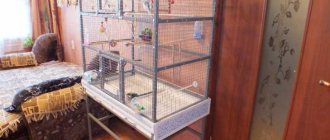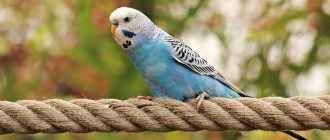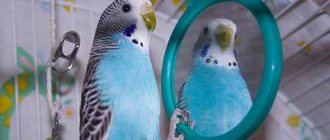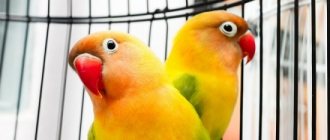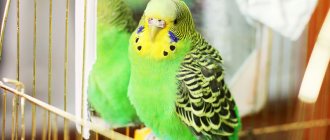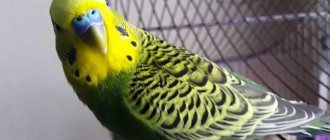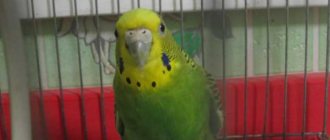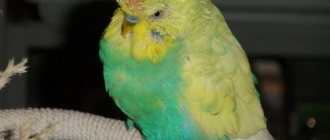Parrots are very active birds that need free range outside the enclosure. If the bird is in normal health and well-being, it should fly every day. If the parrot does not leave the cage, the owner should become concerned and take a closer look at the pet to determine the presence of concomitant symptoms of the disease. If any ailment is detected, immediate treatment must be started. Since birds have an accelerated metabolism, any disease quickly affects a small organism.
Adaptation of a parrot in a new home
In the first days after purchase, the parrot will experience stress, but you should not worry too much about this. This is how adaptation takes place after the purchase. The bird is nervous because it was taken away from its relatives and was left alone. In addition, she was settled in an unfamiliar place. How can you not get stressed here?
Some parrot owners recommend covering one side of the “house” with an opaque piece of fabric so that the pet can find shelter under it. Adaptation of parrots after purchase is a process of getting used to a new place. It is recommended to give the bird several days to develop the territory.
If the parrot does not eat from the feeder for several days, pour food onto the tray, trying not to make sudden movements so as not to scare the bird.
The bird itself will find food and begin to eat. And when he gets used to it, don’t hesitate: he will start using the feeder for its intended purpose every day.
Have you noticed that the bird drinks little? The container with water can not be attached to the wall, but placed on the bottom, and the parrot will drink from there until it fully adapts to the new territory.
It may happen that the bird will sit on a perch and remain silent. This behavior indicates stress due to a change in environment. Don’t worry, all this will pass in a few days and the bird will begin to delight you with its activity and chirping, but for now, leave it alone, try not to scare it. This way, the adaptation period will pass quickly and painlessly for your pet.
Associated symptoms
Along with passive behavior and refusal to leave the cage for free flight, owners often note additional symptoms, such as:
- tousled appearance;
- dirty sewer;
- liquid droppings of various shades, sometimes with a fetid odor;
- vomit;
- refusal of food and water;
- increased drowsiness;
- closing the eyelids with a red tint;
- falling from a perch;
- loss of coordination;
- indifference to the environment.
Important!
If the above signs and strange behavior are detected, it is necessary to carefully examine the bird and, if necessary, take the bird to the clinic for diagnostics and effective treatment.
A parrot's first flight is important
Despite the fact that budgies and cockatiels are domestic, they need to fly, just like their wild relatives. Therefore, if you are thinking about when you can let a parrot out of the cage after purchasing it, and whether it is worth doing it at all, we can confidently say that it is worth it.
You can allow the bird to go free immediately after you see that the bird has become accustomed to its new family, that is, with you!
Many owners are concerned about the question of what will happen if the parrot is not allowed out of the cage at all? This will have a bad effect on his health, he will be depressed, refuse to eat food and may even get sick.
Flight is very important for a parrot. The pet must fly, otherwise the wings may atrophy and then normal activity will remain only a dream for him.
It will be very good for the bird if you allow him to fly without limiting his freedom of action. Also buy your bird a large cage in which you can freely spread its wings and train its muscles. The larger the size, the better, especially if you are planning to have a second bird.
After reading this information, you will find the answer to the question of whether it is possible not to let the parrot out of the cage, because from what is written above it is clear that flight for the budgerigar, and for any other parrot, is as important as air. Bird and flight are inseparable!
Video: parrot learns to fly:
Correcting the situation
In order to return the bird’s love of flying in the apartment again, you should first of all turn to ornithologists for help. It is difficult for a parrot owner who does not have the appropriate education to identify the reasons for the pet’s passive behavior on his own.
A veterinarian will handle this task. After examination and diagnostic procedures, he will first find out the basis and possible pathologies. Then, depending on the individual characteristics of the bird, he will prescribe a therapy program.
If there is no reason for concern, the ornithologist will advise how to correct the situation with the reluctance to fly.
The health, physical and emotional state of the parrot must be carefully monitored. A symptom such as refusal or inability to fly is evidence of illness or physical injury to the bird. Therefore, this sign cannot be neglected. A timely visit to the veterinarian will save or improve the life of your feathered friend.
When and how is the best time to release a parrot from its cage after purchase?
When and how to let a bird out of its cage for the first time? This question plagues many bird owners. Before allowing the bird to take its first flight, make sure that the bird is accustomed to its new habitat. A bird should not be afraid of its owner or other pets.
It usually takes up to three weeks to get used to it. The parrot's first flight should take place in a spare room without dangerous objects or the presence of other pets. If he doesn't want to leave the cage, don't force him.
Perhaps the pet needs time to get used to it, or there is still fear. Give the bird time. You yourself will understand when you can let your budgie out of its cage so that the flight will bring him benefit and pleasure.
Typically, the calmest behavior in birds, regardless of breed, is in the afternoon, so if you are wondering when to let your cockatiel or budgie out of its cage, do it after lunch . Take care of your free time in advance, because you need to watch the bird and make sure it doesn’t get hurt.
It is better not to leave one parrot in the room. You need to monitor your pet's flight: it can cause damage to itself and your equipment - parrots simply love to chew on wires and pull out buttons from the remote control or laptop!
Before releasing your parrot, you must do the following:
- Close windows, doors and vents to prevent the bird from flying outside.
- Remove all dangerous and sharp objects from the premises.
- Remove anything that could get caught during the flight.
- Close mirrors and cabinets.
- The windows need to be covered with curtains, as birds do not notice the glass and can not only hit them, but also be injured. Very often this leads to disastrous results.
- Remove all electrical appliances that are dangerous to birds.
- Put away all the things you value. A parrot can break them, stain them, or drop them.
- Make sure that the bird does not eat plants, as poisoning with many of them can lead to death.
During the flight, it is advisable to observe the following:
- Make sure that the bird does not become entangled in the curtains.
- Do not let your pet fly around the kitchen (especially if something is being prepared in the kitchen.
- Make sure that the bird does not eat indoor plants.
The pet may not immediately leave its shelter, so after opening the door, step away and observe its behavior. At first, the bird may be afraid to be outside the area of its “apartment” - it will rush around anxiously, or it will climb onto the closet and sit there. At this point, do not touch it, wait until it flies to where you can catch it and return it back to the cage.
Recommendations
We will give you a number of general rules that will help you when your pet is flying for the first time:
- The parrot must fly! No matter what arguments are thrown at opponents of the flight of poultry, one cannot escape nature. The bird must fly. Otherwise, she will experience apathy, muscle atrophy and decreased immunity. It is necessary to release the bird into the wild at least once a day;
- A parrot should not fly unattended. This is a mandatory rule. After all, otherwise he may, if not die, then get injured;
- The parrot should not be in a room with other animals;
- The bird should only be fed in a cage;
- Only a hungry parrot should be allowed out for a walk;
- Do not leave the animal outside the cage overnight;
- You should not allow the bird to walk on the floor. This risks the fact that adults may simply step on it.
How to put a parrot in a cage?
Now you know when you can let your parrot out of the cage, but it is also important to know how to return it there after flying around the room. In order to easily put your pet back, you need to study his habits, establish a trusting relationship, feeding him grains. Thus, you can quickly find a common language with him.
Often the bird does not want to go back to its “apartment”, as it likes to play with the owner or do its own bird business. And he will be interested in watching you when you try to catch him. It also happens that a pet sits at the entrance to the house, and as soon as the owner comes to close it, he flies away. This means that the time to return home has not yet come and the bird wants to frolic.
If you let the bird out constantly, it will get used to the regime and will enter the house on its own. The first time, of course, you will have to try to lure the parrot. Monitor its feeding schedule and when you accurately determine the time of eating, allow the bird to go out some time before its lunch. This way, she will fly and return to the house to eat, and you can close the door accordingly.
You cannot catch a parrot with your hands or a towel. Not only will you scare him, but you may also cause injury. In addition, after this the bird will begin to be afraid of you and will stop coming out at all, as it did after buying it.
A soft, dark cloth can be used as a last resort if you urgently need to go away and the bird does not want to return to its home. Having thrown a blanket or piece of cloth over the bird, very carefully and carefully transfer the package into the cage and slowly open it, freeing the involuntary captive.
Some birds like to be carried on their owner's hand or finger. It is very easy to return such a bird back. You can try to lure her with a treat, then she will come back on her own and no problems will arise.
Video: how to lure a parrot into a cage
How often should a parrot be released from its cage?
If a bird has a large, spacious house, then it does not need to be out in the wild often. But, if his home is small, then over time the pet will begin to experience discomfort and the flight will become simply necessary for him.
Be that as it may, each owner decides for himself how often he will walk his pet.
You can release a parrot at least every day. The main thing is to provide him with a safe flying environment.
So that the bird does not get used to freedom, it needs to fly no more than two to three hours, otherwise hysterics will begin, it can jump on the bars, scream loudly, demanding to be released.
In any case, the frequency of your pet's flights will depend on its activity, character and your free time. It is worth keeping in mind that young parrots require freedom regularly!
Take a closer look at your bird more often, and you will definitely understand when the time comes to take its first flight.
Security measures
To prevent the flight from ending badly, the owner needs to prepare a space for the bird to walk.
To do this, you should take a number of security measures:
- Close windows, vents, doors so that the pet does not fly out into the street.
- Cover glass and mirrors with cloth: a bird can crash into them with all its might.
- Isolate domestic cats and dogs in another room.
- Remove household appliances and cover wires.
Birds are released into the wild only during the daytime. A pet flying around the apartment should always be in full view of its owner. The parrot must spend the night in its house.
On a note! In case of any danger, a person must be nearby and provide immediate assistance to the pet. You should put your pet parrot in its cage in time, as soon as it starts to get dark.
How to teach a parrot to fly
The parrot's flights, which take at least a quarter of an hour a day, contribute to the proper development of the pet. Muscles become stronger and life expectancy increases.
The most important rule of the learning process is the voluntary desire of the bird. Completely avoid any violence: tossing or pushing, as you risk losing the bird's trust. The ability to fly is inherent in their nature and the parrot either:
- cannot, since this is the first experience;
- maybe, but doesn't want to.
So, first you should pay attention to the state of the bird’s health and its mood. Make sure the cage is clean and that the water is always fresh and the food is complete. Separate intake of vitamins is encouraged.
After the adaptation period of being in the house has passed, it will be possible to move on to the next stage. Try to show your parrot that the cage has a way out and the surrounding area is at his disposal. The bird will sit on your finger, and you will carry it out of the cage and back several times. Try to do this smoothly, avoiding sudden movements, so as not to scare the bird.
You can try to “hint” him a little about flying. To do this, you need to place it on your finger and slowly move your hand from side to side. Again, do not forget to avoid sudden movements that could cause the bird to lose its balance.
During the training process, you can attract your parrot's favorite toys or food. Place it on a small hill for viewing and simply beckon. Let the bird see a familiar object and make its own decision. A parrot is a curious creature by nature, and if at the moment it is not too scared, then everything should work out.
Don't forget about safety, which must be taken into account. Close and curtain the windows and curtain the mirrors, as glass-related injuries are often the cause of bird death.
Video: parrots fly around the room:
